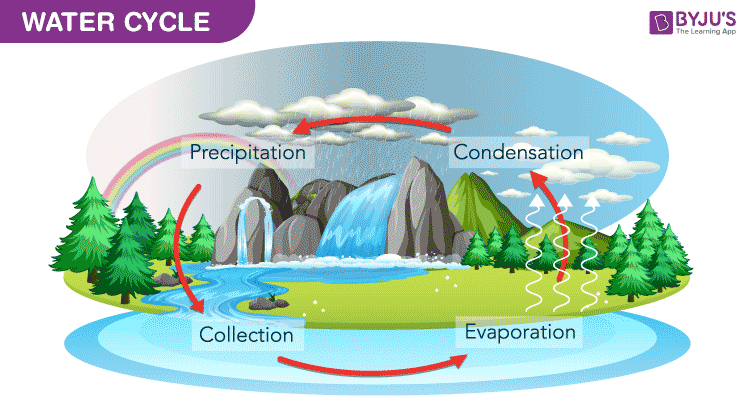Table of Contents
The Water Cycle
The reason behind the rain, cloud, etc. can be understood by studying the biogeochemical cycle also called the water cycle or hydrological cycle.
The water cycle is a multi-phase journey in which the water molecules from the Earth’s surface make their way towards the atmosphere and return. Sun could be called the powerhouse which initiates this process. There is a continuous exchange of moisture from the water bodies, atmosphere, and land surface.

Process of Water Cycle
Most of the moisture found in our atmosphere is a result of evaporation that occurs from oceans, seas, lakes, etc. Evaporation is a process in which the water changes from the liquid phase to the gaseous phase.
Plants also play a role in releasing moisture through the process of transpiration. Plants take in water from the ground through their root system and release them into the atmosphere, with the help of small pores present on the leaves. Sublimation of snow also results in the formation of vapour to a certain extent. Therefore, evaporation, sublimation, and transpiration together are responsible for the water vapour present in the atmosphere.
As water vapours find their way into the lower atmosphere, the air currents raise them up into the higher atmosphere. They undergo condensation there. Condensation is a process in which matter changes its state from the gaseous phase to the liquid phase. Due to condensation and the atmospheric conditions, the vapours get converted into a precipitate such as snow, rain, sleet, or hail. This is the primary system involved in transporting water back to the earth’s surface.
Once the precipitate falls on the surface of the earth, it takes various paths. Some of the precipitates get evaporated. Others seep into the ground while some flow into oceans, rivers, and streams.
Hence, the hydrological cycle repeats itself continuously.
Below is a simple Water cycle diagram, which describes in detail how the Water cycle occurs in the Earth’s atmosphere.

The Water Cycle
Importance of Hydrological Cycle Processes
The hydrologic cycle is one of the four major biogeochemical cycles, which constantly recycles the pathogens, elements, minerals and nutrients along with the water in the ecosystem.
Listed below are a few reasons why the Hydrologic Cycle Processes are important:
- It is also involved in maintaining aquatic ecosystems.
- The hydrologic cycle is an essential biogeochemical cycle on the earth for the maintenance of life.
- The hydrologic cycle plays an important role in ensuring the availability of water for all living organisms, including plants, animals, humans and other living species.
- The hydrologic cycle is the greatest natural process which plays a significant role in the continuous movement of water on, above and below the surface of the Earth.
Also Refer: Importance of Water
To learn more about the water cycle, its significance, activities that affect the hydrological cycle and other related concepts, visit BYJU’S Biology.

Comments